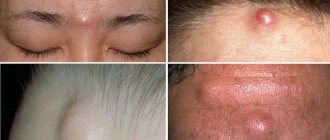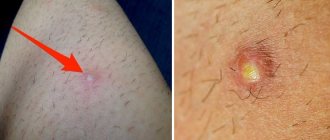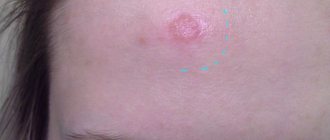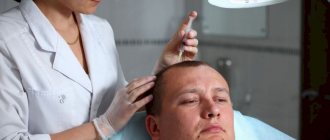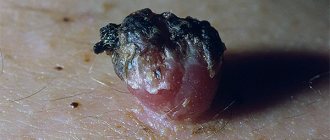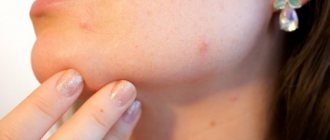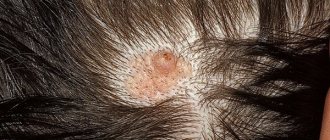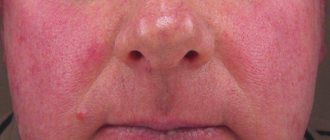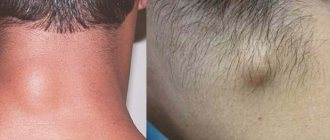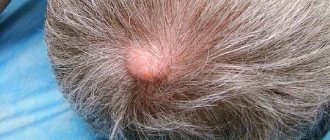Causes of a bump on the head
Painful and painless tubercles, swellings on the head appear in adults and children, lumps can be soft and hard, differ in color - it all depends on the reasons that provoked the appearance of neoplasms.
External factors
The main reason for the appearance of a bump on the forehead is a blow or bruise. On the damaged area, blood begins to accumulate under the skin, a hematoma is formed, it hurts when pressed, and is colored in various shades of burgundy and purple.
Tumors on the forehead, temples and back of the head in the spring-summer season appear due to insect bites, are accompanied by itching, burning, the skin swells, hurts, and a local increase in temperature is observed.
Small tumors may occur due to insect bites
Numerous small red bumps that itch very much are a sign of an allergy to hair care products, food, or the fabric from which hats are made.
A bump on my forehead popped up without impact
The same banned issue for which Ernst fired Malakhov!
Joints and cartilage will be cured in 14 days with the help of ordinary...
Have you been trying to heal your JOINTS for many years?
Head of the Institute for Joint Treatment: “You will be amazed at how easy it is to heal your joints by taking every day...
Read more "
Surely every person at least once in his life felt various tubercles, swellings, swellings and other formations on his head. They may not cause discomfort or hurt when pressed. The reasons for their appearance are different, as are the symptoms and treatment methods. And you need to be able to understand this, because improper treatment can lead to serious consequences.
So, let's look at the reasons for the appearance of bumps on the head:
- injury or bruise;
- a bite of an insect;
- enlarged lymph node;
- lipoma (fat);
- atheroma (cyst);
- furuncle;
- trichoepithelioma;
- osteoma.
External damage
Injury
A bump on the head as a result of a bruise or injury appears after a strong blow and represents a hematoma (limited accumulation of blood under the skin) of a dense structure. It is painful when pressed. Color varies from light lilac to eggplant.
In the first two to three days, you should carefully monitor the condition of the hematoma, because it can fester. This occurs as a result of weak metabolism in the process of resorption of accumulated blood. In this case, the surgeon is involved in the treatment, he performs an autopsy at the site of blood accumulation and cleans the wound of clots and pus. Also, surgical intervention may be required in case of an extensive hematoma - in order to remove blood and prevent suppuration.
A bite of an insect
Most often, insects bite in the spring and summer. Bites usually go unnoticed and rarely cause serious illness. But do not forget that not all insects are equally harmless. There are also insidious ones among them: mosquitoes, bees, wasps, gadflies, and some types of flies. After a bite or sting, swelling, itching, burning, pain, and a local increase in temperature appear.
First aid: you need to treat the skin by washing it with soap and apply something cold to the bite site. Locally, you can use ointments and gels with an antiallergic effect. If the swelling spreads, it will not hurt to take antihistamines orally and consult a specialist. Never scratch a lump that appears after a bite, even if the itching is unbearable.
Neoplasms of soft tissue and bone
Lipoma
Lipoma, or popularly a wen, is a benign tumor formed by fat cells. When pressed, it is dense and most often painless. Unpleasant sensations can occur when the tumor reaches a large size, squeezing neighboring tissues, or contains nerve endings.
The location is most often on the forehead or scalp. The reason for its appearance is insufficient metabolism, heredity, and pathology of adipose tissue. Wen can contribute to mechanical compression of blood vessels in soft tissues, which leads to headaches. The most terrible complication is degeneration into a malignant formation - liposarcoma, but, fortunately, this occurs extremely rarely. Treatment consists of surgically removing the lipoma.
Atheroma
Atheroma, like a dermoid cyst, is a neoplasm associated with a lack of outflow of sebaceous gland secretions. It is most often localized behind the ears, on the face or neck. The cone has a dense elastic consistency, clear edges, and is not located deep. The cause of the appearance is injury, skin diseases, heavy sweating, the predisposing factor is the flask-shaped structure of the sebaceous glands. Atheromas are removed surgically. Afterwards, the material is sent for histological examination to clarify the origin of the neoplasm.
Trichoepithelioma
Trichoepithelioma is a tumor-like formation of the hair follicle that has a benign course. The reasons for its appearance are still unknown, but are hereditary in nature. Most often, this is a multiple tumor (it has the ability to group) and has dome-shaped elements, the diameter of which is no more than 6 mm. The color is no different from skin color or pale pink. Over time it grows. When trichoepithelioma appears on the ear, it can completely close the ear canal. Treatment is surgical or using electrocoagulation.
Osteoma
Osteoma is a benign bone tumor. It grows very slowly, is not capable of malignancy, does not metastasize, and does not grow into neighboring tissues. It is observed in children and adolescents (from 4 years to 21 years), most often in males. It can be either painful or asymptomatic. Rising above the surface of the bone tissue, it has a spherical shape, smooth to the touch, with clear and even edges, motionless.
The origin of osteoma is hereditary (almost 51%). There have been cases of syphilis, gout, and rheumatism appearing after injury. Treatment is exclusively surgical - the tumor is removed with mandatory excision of adjacent bone tissue. Without clinical manifestations, requires routine observation.
The same banned issue for which Ernst fired Malakhov!
Joints and cartilage will be cured in 14 days with the help of ordinary...
Inflammatory diseases
- When injured by atheromas, cysts or hematomas, a secondary infection may occur, which leads to the formation of an abscess. The skin turns red, swells, a local increase in temperature appears, and the lump hurts. The atheroma cavity spontaneously empties with the release of a capsule filled with pus. If this does not happen, the surgeon opens and cleanses the bag of contents.
- A furuncle is an inflammatory disease of the hair follicles. Causes: injury when combing, hypothermia, failure to comply with personal hygiene rules (washing your hair too rarely), the use of certain shampoos and hair masks, for example, for baldness. Externally it looks like a dome with a white head in the center. There is swelling, swelling, redness, severe pain when touched; when pressed, a hole remains, which indicates the presence of pus in the cavity. If left untreated, a boil can cause severe complications, regardless of whether it is on the head or another part of the body. The most dangerous are purulent diffuse inflammation (phlegmon), thrombosis of the cavernous sinus and brain abscess. These diseases are difficult to treat and can be fatal. It is strictly forbidden to delete it yourself! After all, improper treatment can lead to serious consequences. Only a surgeon will help get rid of the boil by opening it.
- Inflammation of the lymph nodes (organs of the lymphatic system that are responsible for the body's immunity) also causes the formation of bumps on the head. The cause may be infectious diseases (otitis media, furunculosis, rubella), fungal infections, and pediculosis. Enlarged lymph nodes are a warning that an infection has entered the body and a call to see a specialist. When inflamed, they swell 2 cm or more in size, are painful on palpation, and hard to the touch. Redness of the skin in this area is noted, body temperature is kept within 37-38 degrees. Various compresses, lotions, iodine nets, and especially massage are contraindicated. Treatment of the lymph nodes themselves will not bring any result, because their inflammation is a consequence of a serious illness. With proper therapy and taking antibacterial drugs, the lymph nodes shrink to their previous size.
Disease symptoms and first aid
| Name of the disease | Symptoms, complaints | Appearance | Treatment |
| Hematoma | Pain at the site of injury, redness, swelling. | Has a color from light lilac to eggplant, dense structure | Immediately after the blow, apply cold, after three days - compress, physical procedures. |
| A bite of an insect | Pain, burning, itching, swelling, redness, local temperature increase | The bite site rises above the skin level, is hot to the touch, has a dense structure | Immediately after the bite, wash with soap, use ointments and gels, take antihistamines orally. |
| Lipoma (wen) | Firm to the touch, most often painless | Ball type, movable. Soft structure, but the deeper, the denser. | Removal is indicated by introducing a special substance that dissolves the wen, as well as surgically or with a laser. |
| Atheroma | Ball-shaped neoplasm. | It has a dense consistency, clear boundaries, and is not located deeply. | Removal by surgery, laser. The biomaterial is sent for histology. |
| Furuncle | Throbbing pain, swelling, redness, fever. | The skin over the boil is very stretched and hyperemic, and a white rod is visible in the center. | Opening the boil in the surgical room, installing drainage for the outflow of pus. If necessary, antibacterial therapy and physical procedures. |
| Trichoepithelioma | Small but multiple formations. | The color is unchanged or light pink, the diameter of the formations is 2-6 mm. | Surgical, using laser. Electrocoagulation. |
| Osteoma | It can be either painful or asymptomatic. Painful sensations when bruised. | Smooth, hard, immobile tumor, skin color is not changed. | Surgical removal with excision of a small number of healthy cells. |
| Enlarged lymph nodes | Pain on palpation, swelling, redness, low-grade body temperature, weight loss. | Hard to the touch, redness and swelling of the skin in the area, thick consistency | Treatment consists of eliminating the primary disease |
Additional examination methods
- X-rays can reveal formations of bone density (osteoma) or detect the cause of inflammation of the lymph node (rhinitis, sinusitis, chronic periodontitis).
- Ultrasound makes it possible to determine changes in the structure of soft tissues, the presence of softening or a liquid component, as well as the degree of change in the structure of the lymph node during its inflammation.
Which doctor should I contact?
To avoid serious complications, do not neglect visiting a specialist. This could be a surgeon, therapist, ENT doctor, or less often an oncologist. In any case, you will be prescribed an examination in order to identify a diagnosis and eliminate a particular disease.
| Disease | Patient management tactics | Who treats |
| Hematoma | Apply a cold compress, monitor body temperature, apply a pressure bandage. For extensive hematomas, a puncture is performed. | A trauma surgeon or maxillofacial surgeon (if the hematoma is on the face). |
| A bite of an insect | Wash the bite site with soap, apply cold, apply a local compress with dimexide, antibiotics, hydrocortisone, antihistamine and anti-inflammatory ointments and gels. | Therapist, allergist |
| Lipoma | An incision, squeezing out the contents, scraping out the capsule, suturing the wound. | General, maxillofacial or neurosurgeon (on the scalp). |
| Atheroma | Incision, removal along with the capsule, suturing the wound, photocoagulation, laser, laser excision. | General, maxillofacial or neurosurgeon (on the scalp). |
| Furuncle | Application of an ichthyol bandage, compresses with dry heat, UHF, after opening - a bandage with a hypertonic solution, with Levomekol ointment. If it is impossible to open it yourself, surgical treatment is required. In the healing stage, antimicrobial drugs and ointments. | General or maxillofacial surgeon (if located on the face). |
| Trichoepithelioma | The use of cytostatic ointments, laser, vaporization, excision, electrical excision. | General, maxillofacial or neurosurgeon (on the scalp). |
| Osteoma | Removal with excision of a plate of healthy bone. | General, maxillofacial or neurosurgeon (on the scalp). |
| Enlarged lymph nodes | Eliminating the cause of the increase in nodes. | General, maxillofacial surgeon, ENT doctor, dentist. |
For the most part, a bump on the head does not pose a serious danger, especially if it does not hurt. But even in this case, it is worth undergoing an examination to clarify the cause and nature of the formation and to be aware of the possible risks.
Bibliography:
- Surgical diseases and injuries. Sukovatykh B.S., Sumin S.A., Gorshunova N.K. – 2020.
- Atlas of pathology of human tumors. Paltsev M.A., Anichkov N.M. – 2005.
- Acute purulent surgical diseases. B. M. Khromov - “Medicine”, 1965.
Soft tissue neoplasms
Balls and bumps on the head are formed due to blockage of the sebaceous glands, follicles, hair and epidermal cysts contain keratin, epidermal cells, most often painless, characterized by slow growth, what they look like can be seen in the photo.
Types of neoplasms on the head:
- Hairy (tricholemmal) cyst - small bumps on the follicle, appears on the crown, back of the head, in the temporal region. There is liquid inside the sac, it is mobile, has a smooth surface, and rarely degenerates into a malignant tumor.
- Epidermal cyst - a growth consisting of cells of the upper layer of the epidermis, the size does not exceed 5 cm. The lump is colored pink, localized at the bottom or in the center of the head, does not go away for several years.
- Lipoma (fat) - a tumor consists of fat cells, has a dense structure, does not hurt, but when it is large, it begins to compress the nerve endings, causing discomfort. The lump most often appears on the forehead, scalp, is formed due to improper metabolism, pathologies of adipose tissue, and can be inherited. Wen often compresses blood vessels in soft tissues, causing chronic headaches. In rare cases, it degenerates into a malignant neoplasm - liposarcoma.
- Atheroma - occurs due to a violation of the outflow of the contents of the sebaceous glands, injuries, dermatological pathologies, hyperhidrosis. The neoplasm is watery, has a dense consistency, clear edges, and is localized at the back of the skull or behind the ears.
- Hemangioma is a benign tumor, prone to degeneration, caused by the proliferation of blood vessels in the skin of the head, most often localized behind the ears, on the crown.
- Fibroma - a lump consisting of connective tissue, appears in various parts of the head, can reach large sizes, and over time degenerates into sarcofibroma. Causes: hormonal and endocrine disorders, diabetes.
Inflammatory diseases
If the lump jumps up without impact, then when it is damaged, infectious processes often occur; with an abscess, the skin turns red, the temperature rises, pain appears, and purulent contents accumulate in the tumor.
What types of bumps occur during inflammation:
- Furuncle is an inflammatory process in the follicles caused by staphylococci that develops due to injury, scratching, hypothermia, and failure to comply with hygiene rules. The dome-shaped tumor has a white core, the skin around it swells, turns red, hurts on palpation, after pressure a dent remains, and white contents mixed with blood are released. When boils recur, furunculosis develops.
- Folliculitis is an inflammatory pathology, consisting of multiple red small bumps in the form of nodules, which occurs when hair follicles are affected by staphylococcal infection.
- Seborrheic dermatitis is a fungal inflammation of the skin, in which multiple white, pale yellow flaky scales and small numerous light bumps appear. Pathology occurs against the background of prolonged stress, poor ecology, and genetic predisposition.
- Psoriasis is small, numerous white formations on the skin that itch, hurt, and the skin turns red. The disease is chronic, recurrent, and inherited.
- Inflammation of the lymph nodes is a consequence of otitis media, colds, rubella, furunculosis, mycoses, and pediculosis. The affected areas hurt when pressed, become hard to the touch, the temperature rises to 37.5 degrees or more, small symmetrical lumps appear behind the ears.
Inflammation on the scalp may also indicate seborrheic dermatitis
Cones in children
The main reason for the formation of lumps in a child is a fall, blows, bruises; due to thin and sensitive skin, the tumor quickly increases in size. If nausea, vomiting, loss of consciousness, or pale skin occurs, immediate hospitalization is required.
Newborns often develop a small tumor with blood inside - a cephalohematoma, which occurs due to head trauma during a difficult birth. The formation is not dangerous for the baby; it is removed surgically.
Osteoma is a benign bone lump that is incapable of degenerating into a malignant tumor, grows slowly, and occurs predominantly in boys and young men aged 4–21 years. The lump has a spherical shape, clear and even edges, is motionless, and sometimes causes painful sensations when pressed. The causes of its appearance are hereditary factors, injuries, congenital syphilis, rheumatism, gout.
In adolescence, children often develop wen due to increased sweating, poor hygiene, and active work of the sebaceous glands.
What is it and features
The appearance of a tumor on the surface of the scalp in most cases does not pose a threat to health. Lipoma can form on the forehead, cheek, temple, behind the ear. The wen does not hurt, does not itch, and does not cause any other discomfort other than a cosmetic defect. The aesthetic side of the problem becomes the reason for the desire to get rid of the growth.
The size of the wen varies from a pea to a chicken egg or a large apple. The peculiarity of lipoma is that it grows slowly, unlike atheroma. Sometimes a wen can remain under the skin for many years and not increase in size. Under the influence of internal processes or external factors, the neoplasm can reach enormous sizes: up to 20 cm in diameter.
Lipomas are characterized as benign formations and according to ICD-10 they are assigned code D 17.
Diagnostics
Identifying the causes of bumps on the head begins with an examination, taking an anamnesis, after which the doctor prescribes tests.
Diagnostic methods:
- general blood and urine analysis - to identify inflammatory processes in the body;
- tumor marker test;
- x-ray of skull bones, ENT organs;
- Ultrasound - allows you to see the contents of the cones.
An ultrasound of the head will make it clear that there are lumps inside
When lumps of any origin appear in the hair, a tissue biopsy is required to identify the presence of cancer cells.
Is there a danger to life and health?
Very rarely, the wen undergoes malignancy, that is, atypical cells appear in its structure, and liposarcoma develops. To eliminate such a danger, you should undergo a full cycle of examination by a dermato-oncologist. The doctor may prescribe a cytological analysis, ultrasound, or taking part of the tumor for a biopsy. Diagnostics will help you choose the optimal treatment method and exclude other types of pathology with similar symptoms.
The tissues of the head are rich in blood vessels, and the treatment of any pathology localized here should be treated with special attention. At the first symptoms of trouble, you should seek medical advice. Self-removal of a wen on the head is dangerous because there is always a risk of infection and spread.
How to get rid of a bump on your head?
To remove a bump on the head, medications are used that eliminate itching and inflammation, but most often surgical methods of treatment are used in therapy.
Treatment with drugs
Medicines are effective for bumps that occur due to injuries, allergies, and insect bites.
How to treat bumps on the head:
- ointments with absorbable action to eliminate hematomas and swelling - Troxevasin, Rescuer;
- antibiotics are prescribed after removal of the lump - Levomycetin, tetracycline ointment, Zinerit;
- antihistamines to combat itching, swelling - Suprastin, Tavegil;
- enterosorbents help to quickly remove toxins from the body in case of allergies and after bites - Enterosgel.
Possible consequences and complications
The main danger of lumps is the possibility of their degeneration into malignant tumors; metastases spread to the tissues of the head, brain, and lymph nodes.
Severe complications arise from purulent processes in the cones; if treatment of the boil is not started in a timely manner, phlegmon, thrombosis, brain abscess, and pathological processes in the bones of the skull develop. All these diseases are difficult to treat and often result in death.
If you let a lump grow, it can develop into a malignant tumor, don’t risk it
Bumps on the head occur due to bruises, insect poisoning, allergies, they respond well to drug treatment and go away quickly. If the tumor is caused by inflammatory processes, disturbances in the functioning of the sebaceous glands, pathologies of soft and fatty tissue, they are removed through surgery.
Rate this article ( 2 ratings, average 5.00 out of 5)
The appearance of a bump on the head, regardless of location and characteristic features, should cause concern. The formation may be soft or hard to the touch, painful or insensitive, located in the scalp or in open areas of the scalp. Based on the appearance of the lump, type of origin, sensations and growth rate, you can make a preliminary conclusion about how dangerous it is. The final diagnosis, confirming or refuting the presence of a serious disease, must be determined by the doctor based on the results of the examination.
Are wen on the head dangerous?
A fatty tumor is not a cancerous tumor. It is dangerous only because it damages the beauty of the human body. But when such a benign formation on the head increases, then:
- It begins to put pressure on nerve endings and blood vessels, which leads to painful sensations and a change in skin color to red with a purple tint.
- Being near the eye can cause decreased vision. This type of wen also hurts when pressed.
- Located in the auricle, it can lead to hearing loss.
Living with subcutaneous tumors on the head, even if they are the size of a pea, is difficult. For example, a lipoma of the scalp is dangerous because if it is frequently injured by a comb, it can become infected with a bacterial infection, grow and impair blood circulation in the skin, which increases the risk of baldness.
Causes of a bump on the head
The multiple reasons why a bump may appear on the head are divided into three main groups:
- Insect bites - a bump in the form of a tubercle and redness occurs at the site of the bite due to an allergic reaction caused by insect venom entering the bloodstream.
- Injuries - a painful lump and swelling of the soft tissues appears at the site of the injury. The size of the lump in such cases depends on the nature of the injury and the intensity of the blow.
- Subcutaneous tumors - benign and malignant formations appear due to improper division of soft and bone tissue cells. Some may cause painful sensations, while others may not manifest themselves at all. The rate of their growth depends on the type of tumor, which include hemangiomas, osteomas, lipomas, warts, atheromas, etc.
To understand what caused the bump on the head, you need to analyze the accompanying symptoms and consult a doctor for advice.
Lump on the head: what could it be?
If you hit your head hard on a hard surface, a bump may appear at the site of the traumatic impact, which is painful to the touch, swelling and redness of the skin. In the first minutes after the blow, it is advisable to apply a cold compress to the site of the injury for 15 minutes, which will reduce the likelihood of swelling and pain. If the bump after a bruise does not go away after a few days, and you have a constant headache, you should visit a doctor to rule out a concussion.
Allergy
When the body is exposed to allergens (for example, cosmetics, household chemicals, certain products), numerous bumps may appear on the head, which become red and very itchy. To get rid of them, you need to take an antiallergic drug and eliminate the influence of the allergen. This may require changing your diet or giving up certain skin and hair care products.
One of the causes of an allergic reaction in the form of a bump on the head is an insect bite. A swelling appears at the site of the bite, which can be very painful and itchy, as well as redness or paleness of the skin. Immediately after the bite, the swelling should be washed with water and laundry soap, take an antihistamine, and lubricate it with “Zvezdochka” balm. If the lump continues to grow and your health noticeably worsens, you should immediately seek help from a doctor.
Lipoma (wen)
A benign formation of a round shape, in most cases painless, soft and mobile to the touch. It occurs due to hormonal imbalances and fat metabolism. When a lipoma is diagnosed, its removal is indicated in several ways: laser, surgically, or by injecting a special drug inside that resolves accumulated fat.
Osteoma
A benign bone tumor that never transforms into malignant. Most often it is a painless lump of regular shape, hard to the touch. The skin at the site of the tumor does not change color. When diagnosing osteoma, the patient is advised to monitor the tumor over time. If the growth of the lump begins to affect the brain centers or cause cosmetic discomfort, the neurosurgeon excises the tumor along with nearby healthy cells, and the removed section of the skull bone is replaced with a titanium plate.
Describe your problem to us, or share your life experience in treating the disease, or ask for advice! Tell us about yourself right here on the site. Your problem will not go unnoticed, and your experience will help someone! Write >>
Atheroma
A growth on the skin, which looks similar to a lipoma, appears due to blockage of the sebaceous glands. The formation of a dense consistency has a yellowish tint, and over time it begins to hurt and cause discomfort. Atheroma is subject to laser or surgical removal, and the excised material is sent for histological examination.
Furuncle
A dense and painful lump occurs against the background of a purulent infection. The swelling has a pronounced reddening of the skin; in its center you can see a white rod. The maturation of the boil is quite often accompanied by elevated temperature. To treat an abscess, it requires opening it in a medical facility, cleaning it, and installing drainage to allow the pus to drain out. Antibacterial and healing ointments and physical procedures can be used as prescribed by a doctor.
Hemangioma
A benign tumor that can develop into a malignant tumor over time. The cause of the formation filled with blood is the abnormal proliferation of venous vessels under the scalp. If you look closely, you can see a vascular pattern under the bump. The most common location of the tumor is behind the ears, in the eye area. It is recommended to remove the hemangioma surgically and send the excised material for histology.
Fibroma
A benign tumor growing from the connective tissues of the scalp can appear in any part of the head. The lump can reach large sizes and over time develop into a malignant tumor - sarcofibroma. The causes of formation are hormonal changes, endocrine disorders, diabetes mellitus. Treatment involves observation by an oncologist, and in case of rapid growth, surgical excision.
Treatment methods
There are several ways to get rid of wen on your head. Radical ones are: surgery, laser and radio wave removal. Alternative medicine offers recipes that can be used to treat wen at home. But the effectiveness of such methods can be debated, since their use is not capable of removing the tumor capsule. But adherents of traditional medicine still use her advice. Let's take a closer look at all the methods that allow you to remove a wen on your head.
- Drug treatment
This is a conservative method of treatment, which is characterized by introducing the drug directly into the body of the neoplasm. The medicine destroys fat cells and leads to a reduction in lipoma. Drug treatment is used only for small compactions - up to 3 cm. The disadvantage of the method is the likelihood of relapse.
- Traditional methods
- the beets are grated on a fine grater, a small amount of the pulp is applied to the sore spot overnight. In the morning the compress is removed, and in the evening the procedure is repeated with a new portion. They do this until the lump goes away completely;
- a piece of laundry soap is crushed and mixed with the same amount of grated baked onion. The mixture is fixed on the wen and changed 2 times a day;
- a clove of garlic and unsalted lard 1:3 are passed through a meat grinder, mixed well and applied to the pine cone;
- A few drops of celandine are applied 2-3 times a day to one point on the surface of the lipoma until a hole appears. Now you need to pull the contents out. This can be done with Vishnevsky ointment or half an onion baked in the oven;
- A fleshy aloe leaf that is at least 3 years old will help cure the wen. It is washed and cut lengthwise. The juicy side is applied to the lipoma and carefully fixed. The plant is changed 2 times a day until the cone shrinks and becomes soft. Then they pierce the skin with a needle treated with alcohol and press on the bulge so that it bursts and its contents flow out (you can look at photos and videos on the Internet);
- Vishnevsky ointment will help soften the seal and reduce it in size. Brown liniment is applied generously to a bandage or gauze folded several times. Applying it to the affected area, cover it with oilcloth and seal it with a plaster. The ointment is left to act for 2 days, and then the compress is changed;
- cinnamon for wen is taken orally, 2 teaspoons every day, washed down with plenty of water. And ginger root will help cleanse the body of toxins and strengthen the immune system.
- Lipoma removal by specialists
| Method | Description |
| 1. Surgery | The removal operation is performed by a surgeon. This radical method of treatment is used:
Before cutting out the lump, the doctor must make sure that the disease is not cancer. Therefore, the necessary tests are prescribed in advance. The operation is performed under local anesthesia, and the recovery period is quite short. The advantage of the method is the availability of the procedure and the ability to get rid of the formation without the risk of relapse. |
| 2. Laser therapy | Removing a tumor using a laser is an excellent opportunity to avoid bleeding and infection of the wound during surgery. A laser scalpel disinfects the specialist’s field of activity and at the same time cauterizes damaged blood vessels. The detached capsule is a sign of excluding the recurrence of the lipoma. |
| 3. Radio wave method | It is possible to cure small wen on the head using radio wave surgery. The operation is performed under the influence of local anesthetics. A radio wave knife, just like a laser, effectively, painlessly and bloodlessly removes tumors along with the membrane. |
| 4. Liposuction | In this procedure, the build-up is removed by pumping out the contents of the seal through a small hole. The disadvantage of this operation is that there is no way to check whether the lipoma on the head was completely removed. If the capsule and remnants of pathological fat cells are not removed, then the probability of relapse is 100%. |
A lump on a child’s head and its features
Bumps that appear on children's heads should not be ignored by parents.
The most common cause of their occurrence, regardless of age, is injury. A child may hit his head on a hard object as a result of excessive physical activity, unsteady walking, or during games. A child’s skin is delicate and excessively sensitive, so after an impact the lump grows quickly. If the blow was strong and the bruise caused a rupture of blood vessels, then a subcutaneous hematoma forms at the site of injury.
The first aid for a child when a bump appears after a blow is a cold compress, which should be applied to the bruised area. If you have symptoms such as constant crying, nausea, vomiting, paleness or loss of consciousness, your baby should be taken to the doctor immediately.
Bumps in children can be the result of more than just injuries. They may be a consequence of the following pathological processes:
- Cephalohematoma is a small tumor, inside of which blood accumulates, typical for newborns. The reason for its appearance is a difficult birth, during which the baby’s head is injured when it passes through the narrow birth canal or when a gynecological instrument is used (for example, surgical forceps).
- Enlarged lymph nodes - painful lumps can be felt in the back of the head or behind the ears. The reason for their growth is the reduced functioning of the immune system and the development of inflammatory processes in nearby organs and vital systems.
- Atheroma (wen) - in children, the tumor appears mainly in the back of the head due to blockage of the duct of the sebaceous glands. The cause of the appearance of a wen is poor hygiene or improper functioning of the baby’s sebaceous glands.
Rarely, lumps in children can be caused by the growth of tumors such as fibroids, hemangiomas or lipomas. To exclude the development of oncological diseases and their transition to a malignant form, if a lump appears and grows on the head, not associated with a bruise or insect bite, the child must be shown to a doctor.
Relapse Prevention
To prevent wen on the head from appearing again, you need to try to eliminate the factors that cause increased secretion of sebum. To do this, you need to follow the rules of personal hygiene, use high-quality cosmetics to care for your face and hair, but not over-wash your hair - the more often we do this, the more actively the sebaceous glands work, trying to compensate for dryness in this way. You should comb your hair as carefully as possible so as not to damage the epidermis. And remember that the first symptoms of a suspicious tumor or lump on the head are a reason to immediately consult a doctor. Early diagnosis and treatment will allow you to correctly differentiate the pathology and eliminate the wen without scars.
Author of the article:
Volkov Dmitry Sergeevich |
Ph.D. surgeon, phlebologist Education: Moscow State Medical and Dental University (1996). In 2003, he received a diploma from the educational and scientific medical center for the administration of the President of the Russian Federation. Our authors
Lump on the head: which doctor should I contact?
If a lump on your head hurts and causes discomfort, you should see a specialist and undergo an examination. Depending on the symptoms and reasons that triggered the growth of the lump, the patient, in addition to being examined by a therapist, may need to consult the following doctors:
- Surgeon - in cases where the lump appears due to a hematoma, lipoma, atheroma, boil, wart or suppuration caused by inflammation of the lymph nodes.
- Neurosurgeon – for diagnosed osteoma.
- Allergist – when a lump appears caused by an insect bite or an allergic reaction.
- ENT doctor – for severe symptoms of enlarged lymph nodes.
- Oncologist - if tumors such as hemangioma, fibroma, sarcofibroma are suspected.
To determine the nature of the tumor that provoked the growth of the lump, the doctor may prescribe the following instrumental and laboratory examination to the patient:
- Blood and urine tests (general) - to assess general health and identify inflammatory processes.
- Tumor marker – if a malignant tumor is suspected.
- X-ray – to examine the skull bones for the presence of bone tumors and ENT organs with enlarged lymph nodes
- Ultrasound - to examine soft tissues and determine the contents of the subcutaneous formation. If the lymph nodes are enlarged, examination can reveal the degree of inflammation and the presence of purulent infection.
Feel free to ask your questions right here on the website. Write >>
Treatment is prescribed by a specialized doctor based on the results of the examination.
A formation on the head, regardless of its origin, appearance and location, should be a cause for concern. Similar bumps can appear both on the top and back of the head, in an open area or under the hair. Whether this neoplasm poses a serious danger can be judged by its appearance, growth rate, type of origin and physical sensations.
Medical possibility of deliverance
Medicine does not recommend getting rid of skin lesions on your own, and alternative medicine is not always effective. Self-medicating can only make the situation worse. It is not worth warming up, steaming, or affecting the wen, if it is large, with alcohol-containing products: tissue damage will be the beginning of inflammation.
How to remove a wen without negative consequences and which doctor should I contact? Only a surgeon can do this. Medicine offers 2 main methods, watch the video:
Surgical intervention . In the clinic, after a preliminary examination and passing all the necessary tests, an operation will be scheduled. The duration is on average half an hour, regardless of the size of the wen. Under local anesthesia, the lump is opened and removed.
Next, it is thoroughly cleaned together with the capsule, leaving no individual particles. If the volume of the wen was large, then drainage will be required after removal. It is installed for the first time to drain fluid from the cavity. The rehabilitation period will take about 2 weeks.
Liposuction . A special incision is made on the surface of the wen, a lipoaspirator tube is inserted into the cavity and the contents are sucked out. This method has a negative side, since the wen capsule may remain inside.
Of course, science does not stand still and the times when surgical cutting was the only way are behind us. Today, medicine offers a number of new techniques. These include the following types of removal:
- laser method;
- radio wave.
The laser method is considered less painful. It has a number of significant advantages; the operation takes place under anesthesia. The doctor does not touch the patient, which eliminates the transmission of infections and contamination. There is absolutely no risk of bleeding. The duration of the operation is reduced several times. Laser removal takes place without complications, the rehabilitation period is short and painless.
After the patient receives anesthesia, the doctor makes a skin incision. The skin spreads to the sides. The body of the wen is tightened with a special tool. Using a laser, the surgeon cleans out the contents along with the capsule. Upon completion, stitches are applied.
The laser method is contraindicated for persons under the age of majority and people suffering from diseases of the cardiovascular system, epilepsy, and infectious diseases.
What complications can there be?
Any surgical intervention can cause complications. Most often, the patient encounters the following undesirable manifestations:
- inflammation of an infectious nature;
- hematomas and swelling;
- loss of sensation;
- scarring.
With inflammation, body temperature rises, cramps and headaches may begin. Before you undergo surgery, you need to decide with your doctor. No one will give a 100% guarantee, because it is unknown how the body will react to surgical intervention. However, the qualifications and experience of the surgeon are of paramount importance.
After removing a large mass, fluid may accumulate. During examination and dressing, the doctor pumps out excess fluid. Compression bandages and cold compresses can be recommended.
If the pain is severe, you will need to take painkillers.
If there is a hematoma, it is better to give up alcohol and coffee and monitor your blood pressure. The doctor may prescribe magnetic therapy, ultrasound, darsonvalization.
If you lose sensitivity, you will need to consult a neurologist. You can treat with drugs: Milgamma or Neuromedin. Brief numbness should not be a cause for concern. If this period drags on, it is better not to delay going to the doctor.
Another unpleasant moment is scars. When a lump has been removed from the head or face, scar formation plays an important role. As you know, burned tissue heals much worse after laser removal than cut tissue. The scar matures and forms within 90 days. You can use preparations for applications: ointments or gels. If the scar is bothersome, painful, or fluid appears, you should see a doctor. You can contact a surgeon, dermatologist or cosmetologist.
Types of bumps and reasons for their appearance
There are many reasons for the appearance of growths on the head. All of them are combined into the following main groups:
- Types of neoplasms
Allergic reaction. A growth on the head may be a consequence of the negative impact of some irritant. Allergic reactions are caused by various cosmetics, foods and other allergens. The bumps cause their owner a lot of inconvenience and are unbearably itchy. To avoid such problems, people prone to allergies are advised to review the menu and purchase household goods only from well-known brands.
Hemangioma. It is a large bump on the surface of the head, formed due to disruption of the circulatory system. Intense proliferation of veins leads to the formation of a lump. A network of blood vessels is visible under the red growth. Hemangioma is considered the most dangerous type of tumor. It usually occurs under the hair. The size of the small growth may increase over time, and the lump itself will transform into a malignant tumor. Therefore, it is very important to consult a doctor at the first signs of hemangioma.
Sarcofibroma and fibroma. Fibroma is a benign neoplasm consisting of connective tissue of the epidermis of the head. The tumor can be localized on any part of the body, including the back of the head, forehead, and temples. In an adult, fibroma can reach significant dimensions. The main provoking factors are hormonal imbalance, diabetes mellitus, and genetic predisposition.
The causes of sarcofibroma are similar, but this neoplasm is malignant. In such cases, lack of treatment leads to the death of the patient. Typically, fibroma is dense to the touch and does not cause pain to a person.
Atheroma or dermoid cyst. This is a lump, the formation of which is caused by insufficient outflow of secretions from the sebaceous glands. Most often, atheroma appears on the neck, face or behind the ears. The neoplasm is not located very deep, has clearly defined boundaries and a dense elastic structure. Factors that provoke the formation of swelling are skin diseases, injuries, increased sweating, and pathological structure of the sebaceous glands. Although such a lump on the forehead under the skin does not hurt, it still requires treatment, since the tumor does not go away on its own. The growth is removed through surgery, after which the material is sent for histology, which will help clarify the nature of the tumor.
Lipoma is a benign tumor that forms on damaged fatty tissues of the head. This pathology most often affects women aged 30 years and older. The formation of lipoma occurs due to disorders of fat metabolism and hormonal imbalance. Such tubercles can appear on any part of the body. The formation is soft to the touch, round in shape.
The lump can be found in the back of the head and under the hair. A large fatty tissue can put pressure on soft tissues, causing the patient to experience headaches. The most dangerous complication is liposarcoma, which is the result of degeneration of a lipoma. The tumor must be removed surgically.
Trichoepithelioma. It is a benign tumor of the hair follicle. The causes of the occurrence have not been precisely established, however, it is known that they are genetic in nature. Trichoepithelioma has the ability to group, so most often you can find multiple round-shaped neoplasms with a diameter of up to 6 mm. The tumors have a similar shade to the main skin color or are colored pale pink. Over time, the size of the lump may increase. When localized on the ear, it can completely block the ear canal. Treatment is carried out using electrocoagulation or surgery.
Causes and provoking factors
Bumps on the back of the head always form for pathological reasons. Large, small, hard or soft swellings indicate that at some stage a malfunction occurred in the body. Perhaps the sebaceous gland is simply clogged and a common pimple appears. But in case of unfavorable development of events, the formation of a benign or malignant tumor cannot be ruled out.
Often a person discovers a lump when it grows to a size of 1-2 cm. This is a signal of the progression of the disease, especially if the general state of health deteriorates. Seals in the scalp are dangerous and require careful examination of adults and children.
Injury
If a lump appears under the skin on the head after a bruise, then the relationship is easy to establish. This is the name of a closed traumatic injury, which occurs quite rarely in everyday life. Usually a person hits himself when he falls at home or on the street. Seals are formed due to sports and work injuries. New growths are especially dangerous after blows with a blunt object, traffic accidents and falls from a height. Indeed, in such cases they are often accompanied by skull injuries and (or) concussion.
Unlike other parts of the body, the scalp has almost no fatty tissue, tightly adjacent to the bone. Therefore, after an impact, the blood is not distributed evenly, but accumulates, forming a compaction. Symptoms characteristic of this type of injury:
- severe pain when pressed;
- the appearance of extensive hematoma or pinpoint hemorrhages;
- puffiness, swelling, redness of the skin.
As the lesion heals, the color of the dermis around the lump changes from dark purple to yellow-green. Its size decreases, and then it dissolves and disappears without a trace. If a person has a bump, then an ice pack becomes an excellent protection against hematoma and swelling.
You should consult a doctor immediately if, after the blow, in addition to the bump, you are bothered by attacks of nausea and vomiting, dizziness and headaches. These are specific signs of a concussion that do not go away on their own without consequences.
Allergy to insect bites
Allergies are another common reason why a lump appears on the back of the head. Only it does not develop through the consumption of food or certain medications, or the penetration of pollen or animal hair into the body. A lump in the scalp is the result of an insect attack. These could be mosquitoes, gadflies, horseflies, midges, human fleas living in basements. What indicates the development of an allergy:
- the seal does not hurt even with strong pressure. During a bite, many insects inject bioactive substances into the blood that have anesthetic properties;
- Itching occurs, which makes a person scratch constantly. At the same time, it involuntarily microtraumas the skin, provoking the development of a bacterial infection.
In people who are not predisposed to allergies, only a slight swelling forms after bites. It does not require treatment and disappears within a day. And allergy sufferers often develop large itchy bumps, which resolve after taking antihistamines.
Insects often attack an adult or child in their sleep. They prefer to bite through the thin, delicate skin behind the ears, in the temples and back of the head.
Atheroma
A lump on the head can be nothing more than atheroma. This is a sebaceous gland cyst, which is a cavity with a pasty secretion. Atheroma is a subcutaneous, round, raised, elastic formation. When touched, it is slightly pressed inward due to its soft consistency. Such a tumor easily moves to the sides and grows slowly. If left untreated, it reaches impressive sizes - up to 10 cm in diameter.
When the sebaceous gland is blocked, the secretion does not stop producing. It does not disappear anywhere, accumulates and gradually stretches the walls of the cavity. In this case, there is no unpleasant sensation, itching or pain, because compression of the nerve endings by compaction is excluded. Atheroma does not go away on its own; it requires surgical excision.
When trying to squeeze out the contents of the atheroma, there is a high probability of pathogenic microorganisms introducing into it. A person’s well-being will be aggravated by headaches, suppuration of the lump, and general intoxication of the body.
Lipoma
In everyday life, this benign tumor is called a wen. This is a soft lump on the head made up of mature fat cells. The lipoma is visualized as a round or oblong formation, soft, elastic, covered with unchanged skin. A wen forms on the forehead, in the back of the head, and less often on the top of the head. At first a tiny pea appears, but the swelling slowly increases in size, usually without causing discomfort.
Lipomas do not pose a serious health threat, especially small ones. A large seal can compress the nerve roots, causing pain. If treatment is not carried out, the person does not try to get rid of the wen, then tissue nutrition is disrupted until the formation of an ulcer and a limited area of skin necrosis.
Fibroma
Fibroma in the scalp is a benign tumor consisting of connective tissue. It looks like a small brownish growth, rising 0.5-1 cm above the skin. Fibroma is usually single, but in clinical practice there have been cases of the formation of multiple compactions. It has clear boundaries, is not painful when pressed, and is localized on the back surface of the head.
Like lipoma, fibroma does not pose a threat to human health. But only with its compact size. If the tumor formed several years ago and is constantly growing, then it compresses the surrounding tissues, disrupting their functioning, which is manifested by corresponding symptoms.
Fibroids must be treated. There is a risk of its degeneration and malignancy. It is minimal, but rapidly increases with constant microtrauma of the fibroma surface.
Hemangioma
This is the name of a benign tumor, which consists of cells on the inner surface of blood vessels and is usually detected in newborns. The seal is located on the crown, slightly behind the ears or on the crown. Hemangiomas are not symmetrical, they are localized randomly to the left and right of the longitudinal axis of the skull. Doctors can easily diagnose the following specific bumps:
- occur predominantly in female infants;
- painless when touched;
- rise above the surface of the skin only a few millimeters;
- have clear outlines;
- do not move when pressed.
Which doctor should I contact?
If a bump on the head causes a lot of inconvenience and pain, you must definitely consult a specialist and undergo an appropriate examination. First of all, you should visit a therapist, who, after examining and finding out the causes of the growth, can refer the patient for a consultation with the following doctors:
- Allergist - in case of lump formation after an insect bite or exposure to any other irritant.
- Neurosurgeon - if the development of osteoma is suspected.
- Surgeon - when the formation arose due to a boil, lipoma, wart, atheroma, hematoma, suppuration caused by an inflammatory process in the lymph nodes.
- Oncologist - in case of detection of fibroma, hemangioma, sarcofibroma.
- ENT doctor - with pronounced signs of enlarged lymph nodes.
Diagnosis of pathology
To find out why the lump appeared, as well as to confirm the diagnosis, the doctor may prescribe the following diagnostic measures:
Treatment of neoplasms
For insect bites and bruises, you just need to apply ice or a cold compress to the damaged area. To speed up the process of resorption of the cone, special ointments and creams are used. For example, these could be drugs such as Troxevasin, Bodyaga, Rescuer. They help eliminate swelling and speed up healing of the growth.
Hemangioma, fibroma and atheroma are usually removed surgically. After surgical procedures, the patient is prescribed antibiotics. The wound canal must be treated with an antiseptic, after which a sterile bandage is applied. Nowadays, an innovative method of treating bumps on the head – laser therapy – is gaining more and more popularity. The operation in this case is less traumatic, and recovery occurs much faster.
As a rule, a bump on the head is not dangerous to human health, especially if it is painless. However, the appearance of any compaction should be a reason to visit the clinic and carry out diagnostic measures.
Ignoring the symptoms of tumor formation can lead to the development of severe complications, including death.
“>
Traditional methods for solving the problem
If we are talking about lumps, which are neoplasms, the question of using folk remedies may not be relevant. At a minimum, because a woman will not be able to independently determine the nature of the tumor and its quality. It is better to entrust the treatment of such formations to specialists who, in most cases, will prefer to resort to surgical intervention, which will get rid of the problem once and for all.
When the lump arises due to a bruise, and you want to get rid of it as soon as possible, it makes sense to think about resorting to the help of traditional methods of treatment.
The most common method of dealing with bumps from bruises is compresses with medicinal plants such as golden mustache and aloe. For the procedure, one sheet cut lengthwise is enough. It is applied directly to the place on the skin where the problem is localized.
Since the previous method is designed for additional fixation of the compress using an insulating bandage, it will not be convenient to use it on all areas of the head. There is another opportunity to speed up the process of lump resorption. To do this you will need regular food salt. It is dissolved in water, and lotions are made from the resulting solution.
Comments
- megan92 () 2 weeks ago
Has anyone managed to get rid of papillomas in their armpits? They really bother me, especially when you sweat.
- Daria () 2 weeks ago
I have already tried so many things and only after reading this article, I was able to get rid of papillomas in the armpits (and on a very budget). PS But I’m from the city myself and didn’t find it on sale here, so I ordered it online.
- megan92 () 13 days ago
Daria, post a link to the article! PS I'm from the city too))
- Daria () 12 days ago
megan92, that’s what I wrote in my first comment) I’ll duplicate it just in case - a link to the article.
- Sonya 10 days ago
Isn't this a scam? Why do they sell on the Internet?
- Yulek26 (Tver) 10 days ago
Sonya, what country do you live in? They sell it on the Internet because stores and pharmacies charge outrageous markups. In addition, payment is only after receipt, that is, they first looked, checked and only then paid. And now everything is sold on the Internet - from clothes to TVs and furniture.
- Editor's response 10 days ago
Sonya, hello. This drug for the treatment of papillomavirus infection is indeed not sold through pharmacy chains and retail stores in order to avoid inflated prices. As of today, you can only order on the official website. Be healthy!
- Sonya 10 days ago
I apologize, I didn’t notice the information about cash on delivery at first. Then everything is fine if payment is made upon receipt.
- Margo (Ulyanovsk) 8 days ago
Has anyone tried traditional methods to get rid of warts and papillomas?
- Andrey A week ago
I tried to burn off a wart on my head with vinegar. The wart really went away, only in its place there was such a burn that my finger hurt for another month. And the most annoying thing is that after a month and a half, two more warts popped up nearby ((
- Ekaterina A week ago
I tried to burn out the papilloma with celandine, but it didn’t help, it just turned black and became so scary (((
- Maria 5 days ago
I recently watched a program on Channel One, they also talked about this PAPIFEX. Many doctors recommended for treatment. I ordered it, I use it, and indeed, the papillomas are dissolving one by one, there are only 2 left, the most tenacious ones.
- Elena (dermatologist) 6 days ago
Maria, soon these two will disappear too!
- Alexandra (Syktyvkar) 5 days ago
A good product, completely worth the price. I have never seen any analogues.
- Maxim Today
Has anyone tried to reduce papillomas with liquid nitrogen?
- Tatyana (Ekaterinburg) Today
Yeah, you burn one, after a month three more grow ((I don’t recommend liquid nitrogen, although hospitals often use it
- Elena (dermatologist) 6 days ago
Tatyana, liquid nitrogen is a thing of the past, now PAPIFEX is used in full and there is no need to go to the doctors!
- Mikhail (Moscow) Today
PAPIFEX also helped (I ordered it according to the advice above), it should work, try it
- Vika (Ekaterinburg) Today
That's great! I need to order, otherwise I’m already tormented with these warts! After all, a woman always wants to be beautiful!
- Kristina (Minsk) Today
I had papillomas removed with a laser, quickly and without pain. But it's damn expensive.
